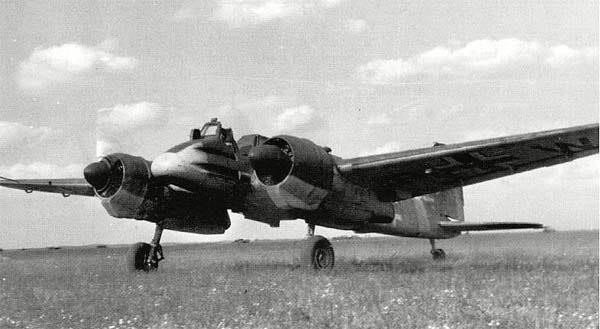Henschel Hs 129 History
The 1938 Reichsluftfahrtministerium (RLM) specification that resulted in the Henschel Hs 129 was prompted by the need, revealed during the Spanish Civil War, for a specialised close support and ground-attack aeroplane.
The Henschel aircraft was designed by Dipl Ing Friedrich Nicolaus, detailed work being completed on the aircraft by the middle of 1938. The first prototype, the Hs 129 V1, flew in the spring of 1939. It was a small low-wing with a triangular-section fuselage and two 465 hp Argus As 410 twelve-cylinder inverted-vee air-cooled engines. The airframe was built of light alloy with stressed skin and 5 mm armoured plated protecting the engines. The nose, in which the pilot sat, comprised a ‘box’ of 6 to 12 mm armour plates spot-welded together with the windscreen of 75 mm armoured glass. The cockpit was so small that several of the instruments had to be mounted on the inboard sides of the engine cowlings.
Pilot’s reports were highly unfavourable, chiefly due to the aircraft’s inadequate power, and were sufficiently damning to prevent the Argus engined Henschel HS 129A from entering production. The existing Hs 129A-0s were not, nevertheless, too unsatisfactory to pass on to the Romanian Air Force, which used them for some months on the Russian Front.
Meanwhile, Herr Nicholaus’s team produced an alternative design, known originally by the project number P.76, but this was rejected by the RLM, which directed instead that the Hs 129A be adapted to take captured French Gnome-Rhône 12M radial engines. Thus re-engined, and with cockpit and other internal modifications, the type became known in 1941 as the Henschel Hs 129B. The Hs 129B-1, following a batch o seven pre-series Hs 129B-0s, entered production in autumn 1941, and became operational with Luftwaffe units in the Crimea early in 1942. Later, the Hs 129B appeared in numbers in North Africa, being employed primarily as an anti-tank aircraft in both theatres.
Several B-1 sub-types were produced, with various combinations of armament. Standard equipment, as installed in the B-1/R1, comprised two 20 mm Mg 151 cannon and two 7.9 mm MG 17 machine-guns, with provision for a small external bomb load. Without bombs, and with a fixed ventral 30 mm MK 101 cannon, it was B-1/R2; the B-1/R3 had the big cannon replaced by a ventral tray of four MG 17s; the B-1/R4 and B-1/R5 each carried the standard quota of guns, but with a more varied bomb load and photo-reconnaissance camera respectively. The Henschel Hs 129B-1/B-2 was notably successful in the anti-tank role, and prompted the evolution of the all-gun B-2 series.
Final version was the B-2/R4, with a huge 75 mm ventral cannon whose muzzle projected nearly 8 ft (2.4 m) ahead of the aircraft’s nose. A total of eight hundred and sixty-six Henschel Hs 129Bs were built before production ceased in the summer of 1944.










